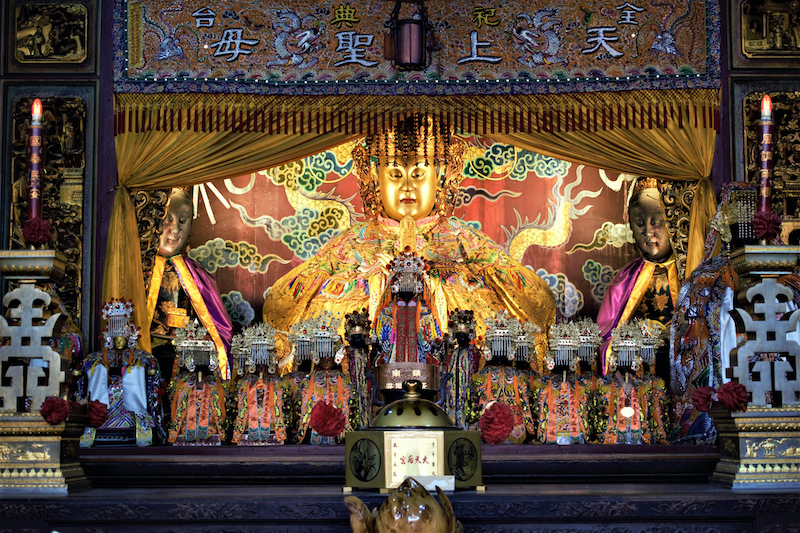
The secret to Taiwan’s successful fight against COVID-19 is its people, not its government.
The Mazu pilgrimage is the largest religious event in Taiwan, and millions of participants usually attend the 186-mile, nine-day, multiple-city journey to celebrate the birthday of the sea goddess.
In February, about one month after Taiwan reported its first confirmed case of COVID-19, the chairman of the Dajia Jenn Lann Temple—one of the major belief centers participating in the pilgrimage—announced that unless the central government ordered the pilgrimage organizers to cancel, the procession would convene as usual during the last few weeks of March. Around the same time that the temple chairman made those statements, South Korea saw the largest single-day spike in COVID-19 cases, which was attributed to the mass religious gathering of the Shincheonji Church of Jesus in Daegu.
Shih-Chung Chen, Taiwan’s Minister of Health and Welfare and Director of the Central Epidemic Control Center (CECC), responded to the temple chairman’s statements, saying that, “although we have the power to prohibit the procession, it does not mean we have to do so.” Instead, the Minister of Health appealed to Mazu’s followers to take care of themselves and to look after one another on the road.
The day after the temple’s initial announcement, its leadership decided to postpone the pilgrimage. The dramatic reversal did not come from any restrictive measure taken by the CECC, but from mounting social pressure in Taiwanese society. Following the CECC’s announcement, an online poll indicated that more than 90 percent of people thought the procession should be postponed or cancelled. People criticized the pilgrimage organizers on social media, discrediting them for their selfishness and myopia. The temple faced a disastrous storm that could not be calmed by the sea goddess.
In early April, the CECC yet again confronted the challenge of crowd infection as people celebrated Tomb Sweeping Day, a time-honored custom when people travel to their hometowns to worship ancestors. In preparation, the CECC issued social distancing guidelines, advising people to stay at least three feet apart and wear surgical masks if they could not maintain a safe distance. Consistent with those guidelines, the Ministry of Transportation required all passengers on trains, buses, and high-speed railways to wear masks, and staff at each station had to check passengers’ temperatures.
The CECC also sent alert messages to people at tourist hotspots nationwide using the Public Warning System. The Public Warning System is designed for government use when there is “immediate threat from disaster or danger” or “attacks from the air, land, or sea.”
The CECC also used the Public Warning System in January to notify people who may have had contact with passengers aboard the Diamond Princess cruise ship, sending messages to smartphone users whose data indicated their potential exposure due to their presence in designated geographical areas.
In both cases, the government worked with telecommunication companies to retrieve the digital footprints of users and trace their travel history. The CECC also suggested that people who visited those tourist hotspots should practice 14 days of self-health management, including social distancing, mask wearing, and working from home. Although the CECC’s self-health management guidance is mostly advisory, some companies and banks made it mandatory and demanded that employees who may have been exposed take leave.
Taiwan’s overall level regulatory stringency is among the lowest of industrial countries. Yet, to date, Taiwan has reported fewer than 500 confirmed cases and only seven deaths with a population of about 23.5 million people. Comparatively, Japan has reported nearly 17,000 cases and 900 deaths with a population of about 126.5 million people, about five times the size of Taiwan’s population. Furthermore, South Korea, with a population twice as large as Taiwan’s of about 51.6 million people, has reported about 11,500 cases and 270 deaths.
Taiwan has not shut down any school, workplace, market, or public service. Authorities did not impose any kind of lockdown in any city. Public transit is running as usual. So far, the government has not mandated mass testing for COVID-19 and has only tracked suspicious cases and isolated those infected.
Overall, Taiwan has adopted a relatively less-intensive regulatory framework and still has managed to secure a low mortality rate during the global crisis.
How did Taiwan achieve this goal?
Taiwan had a legal infrastructure ready in hand before the COVID-19 outbreak. Drawing from the lessons of the SARS outbreak in 2003, Taiwan’s Parliament, the Legislative Yuan, overhauled the Communicable Disease Control Act in 2004. The updated law provides a standardized procedure to coordinate central and local governments during a pandemic response and empowers the CECC to impose compulsory measures and fine lawbreakers.
The Constitutional Court upheld the constitutionality of such compulsory measures in 2011. The Court conducted a thorough proportionality analysis and concluded that public interest trumps other interests in this case, declaring that “a decision made by the competent authority”—referring to the CECC—“to impose necessary dispositions for compulsory quarantine, balancing seriousness of epidemic and surrounding circumstances, will be better than a decision made by the court for prompt disease control.”
The court, however, also mandated the Ministry of Health and Welfare to set a time limit for the duration of compulsory quarantine and follow Taiwan’s Administrative Procedure Act when enacting detailed regulations. Despite these judicially imposed restrictions, some critics argue that the Communicable Disease Control Act, specifically Article 59, delegates to the Ministry of Health and Welfare broad authority to carry out inspection, border control, compulsory isolation, and other measures.
More recently, in February, Parliament passed the Special Act for Prevention and Revitalization, or the COVID-19 Act. Article 7 of the COVID-19 Act provides the director of the CECC with a blank check to take all necessary measures to tackle the virus’s spread. The legislative intent underlying Article 7 was to provide a legal basis for a preemptive regulatory strategy at a time when scientists knew very little about COVID-19.
Initially, there was debate over whether the President should declare a state of emergency using her constitutional authority, rather than rely on such broad legislative delegation to impose strict regulations. The Additional Articles of the Constitution provide the President emergency decree power when there is imminent danger affecting national security or a potential economic crisis. In 2002, however, the Constitutional Court held that the regulations based on an emergency decree must be clear, detailed, and proportionate to public interests. Parliament also must approve an emergency decree within 10 days of issuance.
A key difference between an emergency decree and the kind of legislative delegation found in the COVID-19 Act is whether Parliament or the President will take political responsibility—however, the Democratic Progressive Party won both presidential and parliamentary elections in January. The regulatory basis for COVID-19 response measures is therefore not politically consequential.
Most importantly, although the CECC enjoys immense regulatory power, it does not exercise that power as often as one might think—because it does not have to.
Amid the COVID-19 pandemic, the CECC has been quite restrained relative to the power Article 7 grants it. For example, Article 14 of the COVID-19 Act penalizes the dissemination of rumors or false information regarding COVID-19, either on the internet or by word of mouth. Punishment for violating this provision is a fine of up to $100,000. The CECC, however, has not punished anyone so far—this clause functions basically like a gun behind the door.
Notwithstanding that particular lack of enforcement, the CECC has made some use of its Article 7 power. On top of quarantines and border control, there are two controversies related to the broad delegation of authority in the COVID-19 Act. Both issues impact freedom of travel and movement. First, the CECC banned high school teachers and students from traveling abroad until the end of the semester. Second, medical personnel, including doctors, nurses, and social workers, are not allowed to travel to certain high-alert countries, including Japan, Korea, Singapore, China, and others. The CECC justifies these regulations in the name of public interest, since individuals subject to these restrictions are more vulnerable to infection or play a critical role in prevention.
Taiwan has also adopted restrictive measures such as establishing digital fencing and requisitioning mask production for national rationing.
Most of the time, however, people react more aggressively than the government does. In the case of Mazu pilgrimage, for instance, it was not the CECC but public opinion that stopped the Jenn Lann Temple from continuing the annual procession. And in the case of Tomb Sweeping Day, companies and banks, rather than government officials, required employees to stay at home. The government’s use of the public warning system simply nudges people to comply with social distancing without using an iron-hand policy.
The efficacy of soft regulation depends on proactive compliance from members of society. The government released information about the virus as early as mid-January, and citizens took it seriously. At the beginning of February, many large-scale events such as the Taipei International Book Exhibition had been canceled.
Although this proactive attitude might sometimes lead to overreaction or increased anxiety, it can also ease the government’s regulatory burden, since the government only needs to collect information and coordinate resource allocation rather than expending effort on enforcement. In Taiwan’s case, imposing a shutdown or compulsory general testing is not necessary because of the public’s commitment to compliance, which comes from experience with the SARS crisis.
Trust in democratically elected and appointed bureaucrats also looms large in the fight against COVID-19. The CECC has demonstrated the perfect combination of democratic legitimacy and scientific expertise. It has held press conferences every day since its establishment and patiently responds to questions from ordinary citizens on social media. Soft regulations with hard individual compliance has been the social foundation of Taiwan’s successful fight against COVID-19.
This essay is part of an ongoing series, entitled Comparing Nations’ Responses to COVID-19.




